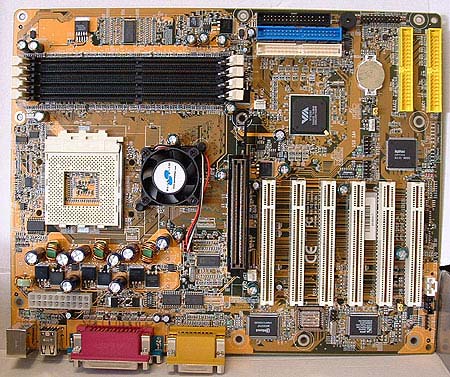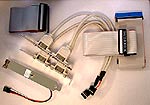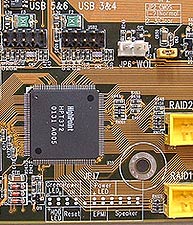Shuttle AK35GTR Motherboard Review
The Shuttle AK35GTR is based on VIA's much loved KT266A chipset, so we already have a pretty
good idea of how fast this board is going to be. Knowing this, what does Shuttle have to offer with the AK35GTR that the competition can't? In one word, price. The AK35GTR is packed full of features and rivals Abit's KR7A-RAID as one of the most feature rich KT266A-based boards we've reviewed. With one 4xAGP slot, six PCI slots, on board hardware based 5.1 audio using the CMedia 8738 chipset and most notably on board Ultra/133 IDE RAID (using Highpoint's HPT372 controller) there is a lot of stuff on this PCB. The only thing I
wonder about is why Shuttle hasn't adopted a prettier PCB colour, but that's really trivial.
| Shuttle AK35GTR Motherboard |
 |
Ships with the following:
- 2x IDE ATA66/100 Cable
- FDD Cable
- 2x USB bracket
- Driver CD-ROM
- Subwoofer bracket
- User Manual

|
As we can see,
the AK35GTR has a clean layout, and while I do have my
usual complaints about the position of the IDE/Floppy drive connectors, I think I'll give
up it even mentioning it anymore because motherboard manufacturers don't seem to
be listening. It's a war I just can't win!
The ATX power connector is located near
the top of the board right behind the PS/2 and USB ports.
If you are careful about where the ATX power cable sits during
installation you can avoid most problems of restricted airflow to the processor easily enough.
If the ATX power tap were lower down on the PCB, by the AGP
slot for instance, the issue would be significantly more cumbersome.
The area
close to the CPU socket has been cleared of capacitors which is extremely nice
if you need to install a large heatsink, like the Alpha PAL8035 or
just about any Swiftech. The AK35GTR supports a total of three fan headers, which these days is pretty common. Two of
them would be difficult to reach if the video card was plugged into
the AGP slot since they're just about under it.
You will also have to remove the videocard
to install, remove memory as the two sockets are packed in very tightly beside on another.
This is a minor annoyance, and one you usually have to put up with if there are 6
PCI slots (the motherboard can only be so long).
The
AK35GTR has on board 5.1 audio care of C-Media's
8738 chip which seems quite popular. The nice thing is, it's a
actual hardware based soundcard not some codec like the VIA AC'97! As far as
sound quality goes, the C-Media chip is on par with the Sound Blaster Live! series
of cards which are pretty good. The 5.1 audio works with every game
we threw at it, with no hitches, Counter Strike, RTCW,
MOHAA....
Highpoint IDE RAID:
 The AK35GTR comes with the Highpoint HPT372
IDE RAID controller, which has Ultra/133 support and allows for RAID
0, 1 and 0+1. Unfortunately we didn't have any spare hard drives on hand to fully test the RAID features. Look
for an update shortly.
The AK35GTR comes with the Highpoint HPT372
IDE RAID controller, which has Ultra/133 support and allows for RAID
0, 1 and 0+1. Unfortunately we didn't have any spare hard drives on hand to fully test the RAID features. Look
for an update shortly.
Here's a brief explanation of
the different RAID configurations.
RAID 0 is not considered a true RAID since,
there's not data redundancy. What it does is take two drives of the
same size/configuration and stripes them meaning it makes one big drive out of
two smaller ones. This improve performance by cutting hard drive latency by
1/2 since the data is divided equally and written on the two hard drives
and it also increases the data bandwidth by twice. The reason it's not considered
a RAID is because if one drive fails, all data is lost.
RAID 1
mirrors two drives of the same size, in theory, if one drive fails, the other
will take over as the primary hard drive and the system will operate as normal.
This is what is supposed to happen with a SCSI hard drive setup and it actually
works pretty well there. However with IDE it just allows for data redundancy, so
the system usually does crash.

